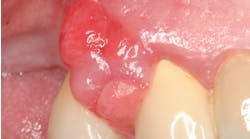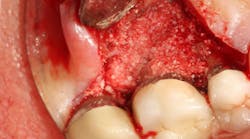The link between periodontitis and cardiovascular disease: A brief overview
On April 18, 2012, Circulation published the article “Periodontal disease and atherosclerotic vascular disease: Does the evidence support an independent association? A scientific statement from the American Heart Association.” This statement was developed in order to assess the concern that periodontal diseases would eventually lead to heart disease. The paper supports a lack of evidence for a causative relationship between periodontitis and cardiovascular disease. However, it does support an association independent of confounding risk factors (i.e., shared risk factors, including smoking). (1) The lay media and elsewhere took this statement as a denial of any links between the two chronic diseases, and de-emphasized the importance of controlling periodontal disease in relation to cardiovascular diseases. One such report stated the potential relationship between the diseases was “not worth stressing out about.” (2) The American Academy of Periodontology released its own statement on the same day clarifying the AHA statement. The AAP agreed that there is not enough evidence to support causation between periodontal and cardiovascular disease. However, they stated that this should not decrease concerns over the potential impact of periodontal disease due to the unknown mechanisms of both diseases. Furthermore, it has been shown that controlling periodontal disease decreases systemic inflammation, which is a major risk factor for cardiovascular disease. This correlation in itself should not be ignored. Both the AHA and AAP called for more research regarding both of the diseases’ mechanisms, long-term interventional studies, and adding periodontal disease to longitudinal studies involving cardiovascular diseases. (3) This article gives a brief overview of literature discussing the correlation between periodontal disease and cardiovascular diseases.
RELATED |The link between periodontal disease and cancer: A review
RELATED |AAP supports ADA: further studies needed to determine causality between periodontal disease and cardiovascular disease
Mattila et al. have commonly been credited with reigniting the interest in examining the relationship between oral and heart diseases in the latter half of the 1900s. In 1989, this group conducted a case-controlled study where they compared the oral health status of patients who had acute myocardial infarctions (MI) and healthy patients. The result was a significant association between poor oral health and acute MI. Particularly important, the group controlled for other factors for heart attack when determining this association. These factors include advanced age, smoking, alcohol abuse, race/ethnicity, education and socioeconomic status, male sex, diabetes mellitus, and overweight/obesity. (4) These potential confounders can limit the progress of studying any interaction between cardiac and periodontal diseases. Just because they are shared does not automatically include or exclude any association or qualify the strength of the putative association.
RELATED |State of the oral-systemic union: 2013
RELATED |The heart of the matter
In 2003, Scannapieco et al. published a major systematic review, seeking to answer whether periodontal disease can initiate or influence the progression of atherosclerosis and therefore cardiovascular diseases/events. The group reported a modest association with atherosclerosis, MI, and cardiovascular events. (5)
Several pathways have been examined to explain this finding. They include those related to systemic inflammation and bacteremia/systemic infection by periodontal pathogens, among others. At the core of cardiovascular diseases is the formation of atheromatous plaques, which are essentially fatty deposits on the lining of arteries. The rupture of such plaques activates thrombosis and leads to acute coronary syndrome, MI, or stroke. (6) Inflammation of the atheroma’s fibrous cap increases the risk of rupture occurrence. This inflammation includes infiltrates of monocytes/macrophages, T-cells, and neutrophils within cap tissues, as well as by increased circulating markers of inflammation in the blood. (6) One such circulating marker is C-reactive protein (CRP), which has been shown to be a prognosticator for future cardiac events. (7,8) Inflammation from periodontitis also increases CRP. (9) Slade et al. (2000) reported that people with extensive periodontal disease had an increase of approximately one-third in mean CRP and a doubling in prevalence of elevated CRP compared with periodontally healthy individuals. (10) Furthermore, it has even been shown that inflamed periodontal tissue produces CRP locally. (11) It follows that the increase of CRP from periodontal inflammation could potentially contribute to the increased risk of future cardiac events. This has not yet been proven definitively, perhaps because we do not know how to quantify the proportion of total CRP that can be attributed to periodontal inflammation vs. other types of inflammation.
Atheromatous plaques also have been shown to harbor bacteria, including those from periodontal pockets. Periodontal pathogens, such as Aggregaticbacter actinomycetemcomitans (AA), Tanerella forsythia (TF), Porphyromonas gingivalis (PG), and Prevotella intermedia (PI) have been found in carotid artery specimens. (12) In addition to being simply present in the plaques, these bacteria can play a role in cardiovascular pathology. For example, PG can adhere to and invade vascular cells, and it has been found that the bacterium can produce factors that induce coagulation. (13) Specifically, PG can interact directly with platelets and express virulence factors called “collagen-like platelet aggregation associated proteins” that stimulate platelet aggregation in vitro and in vivo. (14,15)This can contribute to vasculopathy, namely thrombosis. (14)
It is generally agreed upon that to best investigate periodontal disease’s role as a risk factor for atherosclerotic cardiovascular disease, randomized placebo-controlled clinical intervention trials should be conducted. (1,3) The challenges facing a study of this design is great, due to the time between exposure of a cardiovascular risk factor and the manifestation of the condition (a cardiovascular event), the ethics surrounding controlling these risk factors (such as allowing known periodontal disease to progress), and the necessity to include large numbers of subjects for such a study. Most intervention trials, therefore, have been limited to the effects of periodontal therapy on surrogate markers for cardiovascular disease (like CRP levels). (1)
D’Aiuto and colleagues have done numerous such studies. In 2004, this group examined the CRP levels of 94 systemically healthy patients with generalized severe periodontitis before and after receiving nonsurgical periodontal therapy and extractions. Six months after therapy, the reduction of CRP was significantly associated with the number of extracted teeth and a greater than median probing depth reduction in pockets initially measuring at least 5 mm. (16) In later studies, nonsurgical therapy alone reduced CRP levels at two months, with greater reduction in nonsmokers than in smokers. Systemic IL-6 levels were reduced significantly, in addition to CRP levels, after two months when adjunctive local antibiotics (1mg minocycline, Arestin®) were used. (17) A follow-up was done six months after, and scaling and root planing with adjunctive local antibiotics significantly reduced markers for systemic inflammation than scaling and root planing alone. (18)
To date, only one multicenter pilot study has been performed. Termed the Periodontitis and Vascular Events (PAVE) investigation, patients with periodontitis and a history of coronary heart disease were randomized to either a control group of supragingival scaling only or to a study group of oral hygiene instruction and nonsurgical periodontal therapy. (23) The patients were followed for 25 months, and cardiovascular events seemingly occurred with similar frequency in both groups. However, several factors confound this result. Those randomized to the test group did not keep up with periodontal improvements after the six-month mark. Those randomized to the control group sought a form of preventive or periodontal therapy outside of the study. There was also a very high dropout rate for the study. The control group had 102 subjects at the six-month mark and only 12 subjects at the one-year mark. The test group had 126 subjects at the six-month mark and only 25 subjects at the one-year mark. This essentially nullified the potential effects of the treatments on cardiovascular events received in both groups. Therefore, the conclusion was that there was no difference in adverse cardiac events between test and control groups. (24)
To reiterate the findings of the AHA statement, our current knowledge supports an association between periodontal disease and atherosclerotic cardiovascular diseases and a reduction in local periodontal inflammation after periodontal therapy. Conversely, the notion that periodontal disease can directly cause cardiovascular disease is not supported. In addition long-term reduction in systemic inflammation is not supported with current studies. The fact is, only one multicenter pilot study has been performed and its outcome demonstrates the need for improvements in study design. More information elucidating the pathophysiology of periodontal disease and atherosclerotic cardiovascular disease, and systemic inflammation’s role in each, is required to better understand the association between these diseases. In the meantime, general overall health — including periodontal and cardiovascular health — should be promoted by all health-care providers.
Author bio
Caroline Rubino, DDS, is a postgraduate periodontology resident at the SUNY Stony Brook School of Dental Medicine. She received her BA in biology at the University of Pennsylvania and DDS with honors in research at SUNY Stony Brook. She has been the recipient of numerous awards including the American Academy of Periodontology Award, Blasco C. Gomes Periodontology Scholarship, Dr. Richard J. Oringer Periodontology Award, ADA/DENTSPLY Student Clinician Research Scholarship, and Stony Brook School of Dental Medicine Outstanding Oral Research Presentation Award. Dr. Rubino currently serves as the postgraduate representative for both the Stony Brook Dental Alumni Association and the Honor Code Committee.
References
1. Lockhart PB, Bolger AF, Papapanou PN, et al. Periodontal disease and atherosclerotic vascular disease: Does the evidence support an independent association? A scientific statement from the American Heart Association. Circulation. 2012;125(20):2520-2544.
2. Kincade K. April 18, 2012. AHA: No proof that periodontitis causes heart disease. DrBicuspid.com. Retrieved last from http://www.drbicuspid.com/index.aspx?sec=sup&sub=hyg&pag=dis&itemId=310343 on Dec. 11, 2012.
3. American Academy of Periodontology. April 18, 2012. Periodontal disease linked to cardiovascular disease. Press release. Retrieved last from http://www.perio.org/consumer/AHA-statement on Dec. 11, 2012.
4. Mattila K, Nieminen M, Valtone, V, Rasi V, Kesaniemi Y, Syrjala S, Jungul P, Isoluoma M, Hietaniemi K, Jokinen M, Huttunen J. Association between dental health and acute myocardial infarction. British Medical Journal. 1989;298(6676):779-782.
5. Scannapieco FA, Bush RB, Paju S. Associations between periodontal disease and risk for atherosclerosis, cardiovascular disease, and stroke. A systematic review. Annals of Periodontology 2003;8(1):38-53.
6. Falk E, Shah PK, Fuster V. Coronary plaque disruption. Circulation. 1995;92(3):657-671.
7. Kaptoge S, Di Angelantonio E, Lowe G, Pepys MB, Thompson SG, Collins R, Danesh J. Emerging risk factors collaboration. C-reactive protein concentration and risk of coronary heart disease, stroke, and mortality: An individual participant meta-analysis. Lancet. 2010; 375(9709):132-140.
8. Ridker PM. Clinical application of C-reactive protein for cardiovascular disease detection and prevention. Circulation. 2003;107(3): 363-369.
9. Tonetti MS. Periodontitis and risk for atherosclerosis: An update on intervention trials. J Clin Periodontol. 2009;36(suppl 10):15-19.
10. Slade GD, Offenbacher S, Beck JD, Heiss G, Pankow JS. Acute-phase inflammatory response to periodontal disease in the U.S. population. Journal of Dental Research. 2000;79(1):49-57.
11. Lu Q, Jin L. Human gingiva is another site of C-reactive protein formation. J Clin Periodontol. 2010;37(9):789-796.
12. Aimetti M, Romano F, Nessi F. Microbiologic analysis of periodontal pockets and carotid atheromatous plaques in advanced chronic periodontitis patients. JPeriodontol. 2007;78(9):1718-1723.
13. Dorn BR, Dunn WA Jr., Progulske-Fox A. Invasion of human coronary artery cells by periodontal pathogens. Infect Immun. 1999;67(11):5792-5798.
14. Roth GA, Moser B, Huang SJ, Brandt JS, Huang Y, Papapanou PN, Schmidt AM, Lalla E. Infection with a periodontal pathogen induces procoagulant effects in human aortic endothelial cells. J Thromb Haemost. 2006;4(10):2256-2261.
15. Herzberg ME, Meyer MW. Dental plaque, platelets, and cardiovascular disease. Annals of Periodontology. 1998;3(1):152-160.
16. D’Aiuto F, Ready D, Tonetti MS. Periodontal disease and C-reactive protein-associated cardiovascular risk. Journal of Periodontal Research. 2004;39(4):236-241.
17. D’Aiuto F, Nibali L, Parkar M, Suvan J, Tonetti MS. Short-term effects of intensive periodontal therapy on serum inflammatory markers and cholesterol. Journal of Dental Research. 2005;84(3):269-273.
18. D’Aiuto F, Parkar M, Nibali L, Suvan J, Lessem J, Tonetti MS. Periodontal infections cause changes in traditional and novel cardiovascular risk factors: Results from a randomized controlled clinical trial. American Heart Journal. 2006;151(5):977-984.
19. Amar S, Gokce N, Morgan S, Loukideli M, Van Dyke TE, Vita JA. Periodontal disease is associated with brachial artery endothelial dysfunction and systemic inflammation. Arteriosclerosis, Thrombosis, and Vascular Biology. 2003;23(7):1245-1249.
20. Mercanoglu F, Ofl az H, Oz O, Gokbuget AY, Genchellac H, Sezer M, Nisanci Y, Umman S. Endothelial dysfunction in patients with chronic periodontitis and its improvement after initial periodontal therapy. Journal of Periodontology. 2004;75(12):1694-1700.
21. Seinost G, Wimmer G, Skerget M, Thaller E, Brodmann M, Gasser R, Bratschko RO, Pilger E. Periodontal treatment improves endothelial dysfunction in patients with severe periodontitis. American Heart Journal. 2005;149(6):1050-1054.
22. Elter JR, Hinderliter AL, Offenbacher S, Beck JD, Caughey M, Brodala N, Madianos PN. The effects of periodontal therapy on vascular endothelial function: A pilot trial. American Heart Journal. 2006;151(1):47.
23. Beck JD, Couper DJ, Falkner KL, Graham SP, Grossi SG, Gunsolley JC, Madden T, Maupome G, Offenbacher S, Stewart DD, Trevisan M, Van Dyke TE, Genco RJ. The Periodontitis and Vascular Events (PAVE) Pilot Study: Adverse events. J Periodontol. 2008;79(1):90-96.
24. Offenbacher S, Beck JD, Moss K, Mendoza L, Paquette DW, Barrow DA, Couper DJ, Stewart DD, Falkner KL, Graham SP, Grossi S, Gunsolley JC, Madden T, Maupome G, Trevisan M, Van Dyke TE, Genco RJ. Results from the Periodontitis and Vascular Events (PAVE) Study: A pilot multicentered, randomized, controlled trial to study effects of periodontal therapy in a secondary prevention model of cardiovascular disease. J Periodontol. 2009;80(2):190-201.







